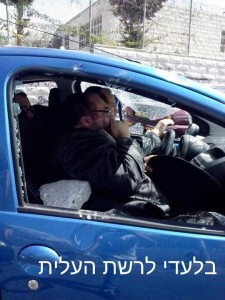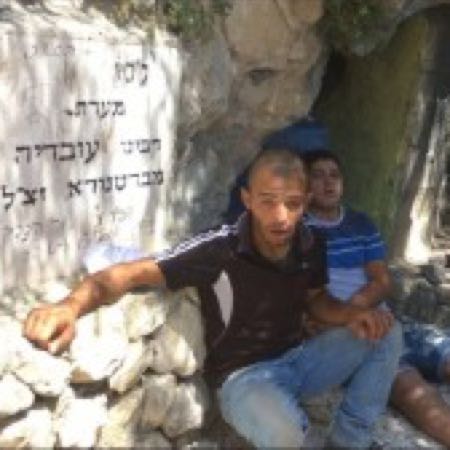Yoeli Harfenes, a resident of Sea Gate, knows a thing or two about survival. A member of Hatzoloh, he just managed to leave the World Trade Center before it collapsed. Last year, his home was in harm’s way as Sandy pelted Sea Gate, but perhaps nothing prepared him for what happened to him and his family on the way to Har Hazeisim on Hoshanah Rabbah.
Yoeli’s story began 22 years when Menachem Nochum Harfenes, his father, suddenly died while vacationing at the Yam Hamelech. He was buried on Har Hazeisim just a few days after Yom Tov. To mark his father’s yahrzeit, Yoeli decided to spend Yom Tov with his family in Yerushlayim, something he had done before. In fact, he has been visiting his father’s kever every year without a problem — that is till he met his nephews by chance at the Kosel Hamarovi on Hoshanah Rabbah. They too were spending Yom Tov with their families in Yerushalayim and when they inquired about the location of their uncle’s (and Yoeli’s father’s) kever, Yoeli offered to take them there. Nephew Yosi Gluck sat in the front and Yoeli’s wife and nephew Meyer Rosen and his wife sat in the back.
It was at about 2:30 in the afternoon as they were driving on the Ator Road, alongside tourist busses and passenger cars, that the unthinkable happened. It was a road he had taken many times to Har Hazeisim without a problem but as his car slowed in the crawling traffic, he suddenly noticed a gang of Arab youths, some with their faces covered, armed with rocks (“boulders,” says Yoeli) heading directly for his rental car. The first rock smashed the passenger side window with force, bloodying Yosi’s face. An Arab youth reached inside punching him all the while on his neck and hand. Yoeli yelled for the back seat passengers to duck as other Arabs were smashing the other windows as well. His instincts as a Hatzoloh member took over as he continued driving, all the while keeping his hand on the horn. By now his front window was shattered and it was very difficult to see. He managed to make the turn to Har Hazeisim on a direct course to the local police station. The two officers in the station called an ambulance for Yosi and soon reinforcements arrived. After taking the report, an officer said that he should drive the blood-stained and glass-laden car to the police station near Shar Shachem (Damascus Gate). When he protested that he could not, an officer drove the car there.
The police station near Shar Shachem was to say the least another frustrating experience. The car with its shattered windows soon became a spectacle as Arabs gathered to enjoy the site. Indeed, even the police officers sensed that and asked Yoeli to move the car. Again Yoeli protested that the car was to say the least not drivable. In the interim, the rental company had come to tow the car. As a parting piece of advice, a Police officer suggested that Yoeli not return for the yahrzeit, a suggestion he ignored. Just before he was to leave to return to the US, he was summoned to the police station in the Russian Quarter. When asked if the car was fingerprinted, he flatly said no.
Yoeli’s experience was apparently one of several during the Yomim Tovim, according to Avrohom Lubinsky, who heads the International Committee for the Preservation of Har Hazeisim. The attacks came after a period of relative quiet in the area and the continued lack of incidents on Har Hazeisim itself due to the 142 surveillance cameras and the police substation. But says Lubinsky, the substation is still not fully manned to the promised levels and the areas leading to Har Hazeisim areas still not safe.
In some of the other incidents, a tour bus came under a hail of rocks on September 10th. The bus carried 54 people from the Ashkelon branch of the Zionist Council in Israel’s Eshkolot project on a selichot tour, to an observation point on the Mount of Olives, when Arab youths began pelting it with rocks. One girl was slightly injured, suffering scratches on her arm from broken glass. A young Jewish couple from the town of Beit El, along with their four year-old son, narrowly escaped death after an Arab lynch mob attacked their car near Jerusalem’s A-Tur neighborhood. Asaf and Naama Bruchi were travelling through the largely Arab neighborhood when their car stopped in traffic. Suddenly, they were pelted by rocks and other missiles, and found their car surrounded by Arab thugs.
Commenting on the lack of police presence in the area, and the seeming impunity of Arab mobs to target Jewish passersby, Asaf said that the feeling he got was that “there is a lack of [Israeli] sovereignty” in the area, an oft repeated comment from victims.
In yet another attack, a vehicle carrying the Toldos Aharon Rebbe was attacked as it made its way to Har Hazeisim, all pointing to the continued lack of security on the approaches to Har Hazeisim. The ICPHH has stepped up its efforts to persuade the government to secure the periphery, according to Mr. Lubinsky. It is currently pressing its case at the highest levels of the Israeli government. “We will not be able to declare Har Hazeisim safe and encourage tourism until the approaches to the 3000 year-old cemetery are secured,” said Mr. Lubinsky.





